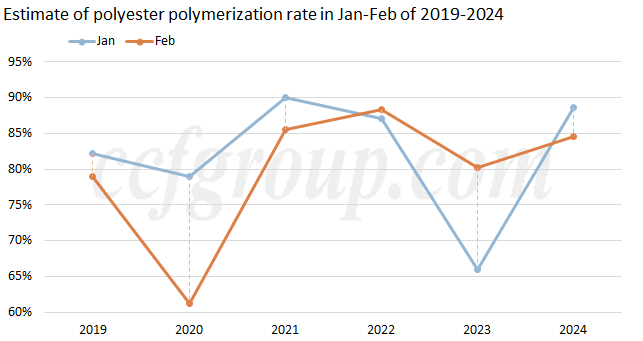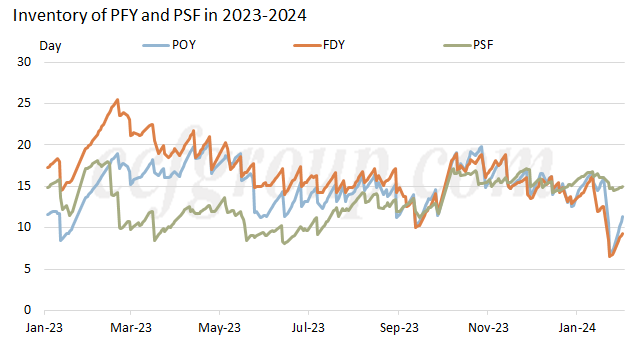What's the reasons for lower expectation of polyester polymerization rate?
As the Spring Festival approaches, the estimated polyester polymerization rate is decreasing.
Initially, according to market expectations, the business of PFY was doing well this year, and the maintenance intensity during the Chinese New Year was expected to be limited. However, large factories have announced production curtailment plans one after another, and it is observed that the start-up time of some units has been noticeably delayed. Some factories even suggested the possibility of new maintenance plans in the future.
The operating rate of PSF plants was not high at first, and there were not many maintenance plans initially. However, it has significantly increased since late-Jan and it is expected that the lowest run rate during the Spring Festival will drop to below 60%, possibly even lower than last year.
As for PET bottle chip market, the operating rate has been low.
Based on the latest run rate assessment, the estimated polyester polymerization rate in Feb has shown a significant decline. Currently, the polyester polymerization rate was evaluated at around 84-85%, although still higher than the same period of last year, it has fallen below the level of 2021-2022 (even after continuously deducting the eliminated capacity). According to the current assessment, the lowest polyester polymerization rate in Feb may fall to 80-81%, likely around Feb 7-8, and the polyester polymerization rate at the end of the month may be below 90%. The specific situation will depend on the actual progress of facility operations and will be updated accordingly.

The reasons for the increase in production reduction and maintenance are not only related to the so-called raw material market dynamics but also largely related to the operational pressure of the companies themselves.
On the surface, after downstream buyers restocked in late-Jan, the inventory of PFY plants decreased remarkably. The inventory of POY and FDY quickly dropped from half a month's supply to one week. However, after this round of restocking, PFY sales cooled down rapidly. Over the past few days, sales ratio of PFY only reached 20-30%. In this process, inventories have rebounded quickly. In other words, compared to previous years, this year's inventory reduction seemed to happen quickly, but the duration was relatively short. Considering that the current inventory was only part of the equity, and many companies have only paid for the goods but have not actually taken them away, the pressure on physical inventory has remained significant.

Currently, downstream companies all have a certain amount of inventory for the post-holiday period (most will guarantee production until mid-Mar to Apr) according to survey made by CCFGroup, although many will be gradually withdrawn after the holidays. On the other hand, it can be expected that downstream purchases will be limited for a short period. According to previous years' experience, Feb has always been a relatively slow month for production and sales. With the current inventory rebounding and heading upwards, inventory is expected to accumulate significantly over the next month.
In early-Feb, PFY inventory can last for about ten days, and sales ratio has basically dropped to 20-30%. From now until the ninth day after the Chinese New Year (February 18), there is still more than half a month. If the average daily sales ratio is maintained at 20-30% (it may be even lower during the holiday period unless there is another round of promotions before the holiday), so by then, there may be a significant amount of inventory accumulation for around ten days (if PFY production reduction expands, the inventory accumulation may be compressed). During the downstream delivery process in the latter half of the month, there won't be much purchasing, further increasing inventory pressure.
This is only the situation for PFY. The inventory of PSF has basically not been reduced much, so the pressure is relatively high. That is why there is a noticeable increase in maintenance plans recently.
Certainly, inventory levels of twenty days or even higher before have appeared before, but because the capacity base has been rapidly increasing these years, the tonnage of inventory corresponding to the same number of days is also increasing. Coupled with the background of factories being located in multiple regions, regional inventory levels may be uneven, leading to greater pressure in some areas.
Lastly, at the current price level, whether it is polyester, cotton, viscose, etc., they are basically higher than the average price of last year. Market participants are not yet certain about the potential demand after the holidays.
Additionally, the cotton spinning industry took early and extensive measures to reduce inventories. Spinning mills had shorter holidays at the end of the year but the start of work after the holidays is slightly delayed. The number of days off during the Chinese New Year period has also extended in some areas compared to last year, so there may be concerns about uncertainties after the holiday.
Of course, it is not ruled out that there will be normal demand release after the holiday, and a round of restocking may occur at the end of Feb (after all, some companies are not fully stocked). Inventory control can also ensure that the market restarts faster after holiday.
Therefore, whether it is based on inventory control or risk control after holiday, the recent increase in production reduction in factories is relatively understandable. Especially after running in recent years, security may be more important for enterprises.
- Top keywords
- Cotton Price
- Cotton Futures Price
- Cotton Futures
- CZCE
- PTA Futures Price
- Chemical Fiber
- Polyester Prices
- Wool price
- PTA Futures
- Shengze Silk
- China
- Yarn Price
- price
- China Textile City
- Fibre Price
- Benzene Price
- Cotton
- Index
- Cotton Index
- PTA
- fabric price
- NYMEX
- Top 10
- textile industry
- Spot Cotton
- Cotton Yarn
- Polyester Price
- Futures
- PTA Price
- cotton yarn price

